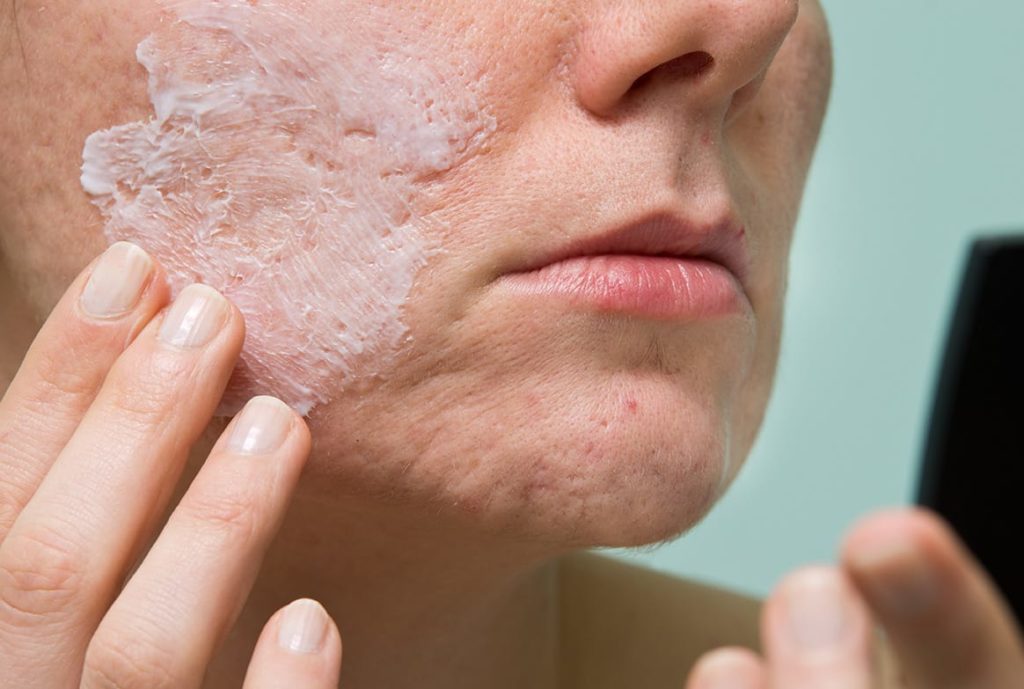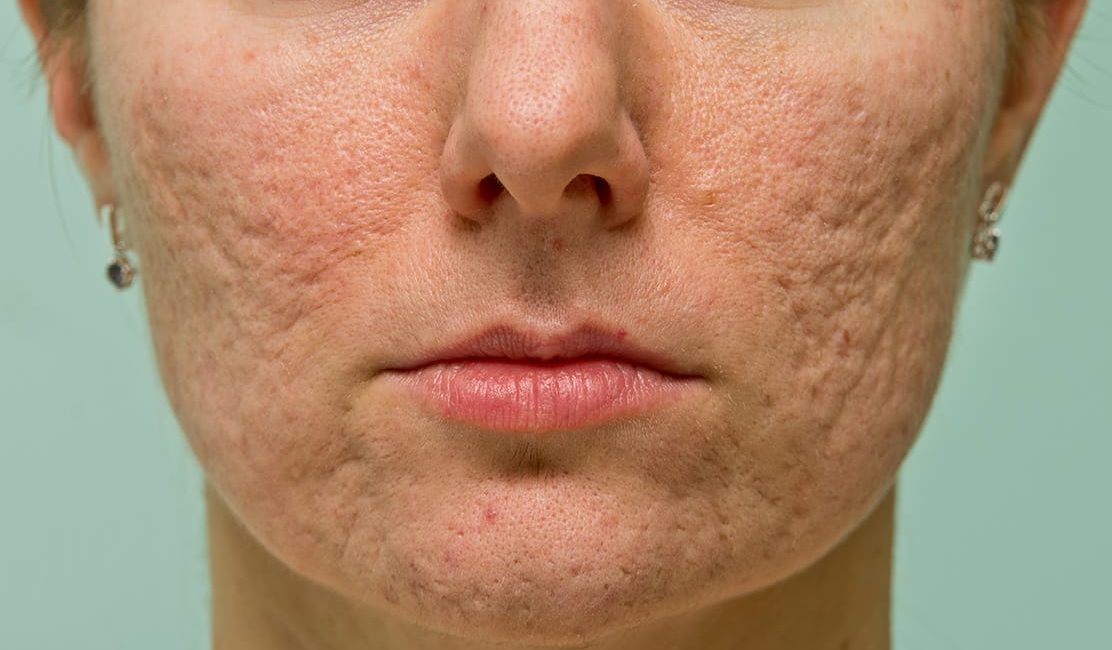Acne scars come in two main categories: excess tissue growth (hypertrophic scars), and loss of tissue (atrophic scars). Ice pick scars fall under atrophic scars due to its deep impressions.
Ice pick scar’s defining character is its narrow and deep-pitted look, also showing sharp borders. These are usually caused by deep acne, such as cystic acne. The pitted scars suffer from loss of skin tissue and collagen damage.
Despite the appearance and severity of these scars, advanced medical treatments are available today to help improve their appearance. Effective Acne Scar Treatments should include the encouragement of collagen production, development of new tissues, and reconstruction of skin. Traditional treatments include non-invasive procedures, surgical, and other resurfacing methods.
It is best to consult an expert doctor to weigh the pros and cons of available treatment options. Everyone has a unique skin condition – what may work well on some, may not work as well on others.
Contents
What are Ice Pick Scars?

Ice Pick scars are one of the severe acne scar types. This can’t be treated at home. Instead, it will need some help from the professionals. Scars of this kind are worse than boxcar and other atrophic scars because of their depth and narrow form. These are commonly seen on the cheeks.
Ice pick scars develop from severe acne lesions, such as from deep acne cysts that have damaged the skin’s structure. The inflammation destroys skin tissues, leaving a column-like scar. Not treating your inflamed acne early on may also lead to ice pick scars, when it should have been avoided if addressed immediately. Popping or scratching pimples may also develop into scars.
Severe inflammation penetrates deep into the skin, damaging underlying tissues. The body will naturally heal the damage by producing more collagen and elastin. When too much or too little collagen is produced, it can lead to scarring. Ice pick scars happen when the body doesn’t produce enough collagen, resulting in pitted skin.
Other atrophic scars, such as boxcar, are thin and flat marks which make them easier to get rid of. Meanwhile, Ice pick scars are more profound, narrower, and are usually less than 2 millimetres wide – making it a more challenging blemish to deal with.
It got its name from the ice pick tool itself. This is because the scars often make the skin look like it has been punctured with a sharp object, like an ice pick. Some scars of this type may have the appearance of a very dilated pore.
Ice Pick Acne Scars Treatments and Reviews
Ice pick scars can’t fade away on their own. They will need some medical help. While natural remedies and over-the-counter products consist of helpful ingredients, pitted scars will need professional treatments to help reduce their appearance.
There are treatments and procedures to help improve the appearance of your ice pick scars and improve the skin’s texture. Your options will depend on your skin condition and severity of the scar.
There are two stages in ice pick scar treatments. The first stage of treatment involves reducing the depth of the scar to even it out with the rest of the skin’s surface. The second stage aims to reduce skin discolouration.
The following treatments may have potential side effects. It is best to consult a skilled and experienced professional to be aware of the pros and cons. Not all treatments work the same on everyone. The effectiveness of the treatment will depend on your skin type and condition. Be sure to give your dermatologist a visit before undergoing any of these procedures.
Subcision
Acne can cause severe scarring, such as those that are deep and may become permanent. This is when subcision treatments come in and work its magic. Damages cause the depression on the skin on the skin fibres. Subcision levels the ice pick scars with the rest of the skin’s surface and eventually heal the area – improving its appearance.
Subcision treats ice pick scars by improving the volume of the area. Pitted scars have fibrotic strands that pull the skin downwards, which explains the indentations. Subcision procedures involve using a special, hypodermic needle that releases fibrotic tissues to break the fibrous bands that causes depression on the skin. It is moved back and forth in a fanning pattern to help cut more of the fibrotic tissues. This releases the tension on the area and allows new and healthier tissues to form.
Other treatments target the skin’s outer layers to reduce the scar’s appearance, while Subcision targets ice pick scars from deep into the layers. This is why it’s effective for pitted, depressed scars. Fillers are used for volumizing the pitted are and for stimulating collagen synthesis, as well.
The price of a subcision treatment will highly depend on several factors: the doctor’s expertise, customized techniques, the severity of the scar, and additional healing fillers. 3-5 treatment sessions are typically recommended with 1 month apart. Also note that this treatment can’t be performed in individuals who have skin infections, and are prone to hypertrophic and keloidal scars.
TCA Cross
Its depth and sharp margins characterize ice pick scars, making it very visible to the naked eye. Since these scars tend to be numerous, it makes the skin look like its aging with the widened and loose pores. Effective treatment for this type of acne scar should include a procedure that could improve the depth of the ice pick scars – one way to do this is to encourage collagen production around the well of the scar.
TCA Cross involves using trichloroacetic acid (TCA) for the rejuvenation and reconstruction of skin areas that are damaged. This chemical is an acetic acid that is usually used as a medium-depth peeling agent and has proven to be safe. TCA works by coagulating proteins while penetrating into the skin, affecting the layers of the skin, both epidermis and dermis.
This procedure consists of depositing small amounts of the chemicals at high concentrations of about 70-100%, on the surface of the ice pick scar. This causes some damage to the epithelial layer of the skin and leads to an inflammatory reaction. The reaction triggers the development of new collagen fibres from inside the ice pick scars, helping reduce its appearance.
Patients who undergo TCA Cross Treatment can expect a 10-40% improvement after each treatment – this will depend on the depth of your ice pick scars. Younger patients may require fewer treatments as they can regenerate collagen faster. It is typically recommended to take 2-4 treatments, with one month apart, to see noticeable improvements.
After the procedure, expect your scars to look a little more damaged. Do not panic. The goal of this treatment is to slightly damage your scar tissues, which may make it a little red and inflamed for a couple of days. The skin’s natural healing process will start doing its work and regenerate new tissues. An antibiotic ointment will be applied to the area after the procedure to help the scar heal and to reduce infection.
Aftercare is also crucial after undergoing a TCA Cross procedure. This is critical to help get faster results. Be sure that your doctor advises you with proper aftercare treatments.
TCA Cross has a higher chance of post-inflammatory hyper-pigmentation and post-inflammatory erythema for individuals with darker skin types.
Chemical Peel
Chemical peels are filled with nourishing vitamins and minerals, which can help improve the appearance of damaged skin. Of course, medical-grade chemical peels are not your usual facial peels that can be done in the comforts of your home. Aesthetic clinics use more concentrated chemical peels in order to address pitted, depressed scars, such as ice pick scars.
This treatment usually uses alpha and beta hydroxy acids to help improve uneven skin tone, smoothen skin textures, and reduce the appearance of acne blemishes. The active ingredients also help speed up cellular turnover.
Chemical peels work by removing the outermost layer of the skin. Standard chemical peels contain glycolic acids, also considered as “medium” peels. Glycolic acid is an AHA (alpha-hydroxy acid) that is used in chemical peel formulations. It is an effective ingredient because of its small molecules that can travel deep into the skin to help diminish the appearance of scars.
“Deep” peels are the most effective of all types of chemical peels. This also has a higher chance of showing promising results when it comes to ice picked scars.
INFINI
INFINI addresses a number of skin concerns such as sagging skin, wrinkles, and acne scars. It is safe for all skin types as it uses insulated needles to make sure the epidermis is minimally affected for faster recovery. The needles allow the RF energy to avoid the epidermis, which reduces the risk of post-treatment pigmentation.
This treatment uses a combination of radiofrequency and micro-needling technique. Radiofrequency is responsible for delivering heat into the skin to trigger collagen production, which effectively tightens and lifts the skin. Microneedling involves using small needles which trigger the skin’s natural healing process, which then also encourages collagen and elastin production.
A handheld device containing 49 microscopic needles is used during the procedure. The user can easily control the device by adjusting it to the preferred depth, intensity level, and treatment zone.
RF energy, or thermal energy, is delivered deep within the skin layers through the gold-plated microneedles. The treatment is done directly deep into the layers which can reach up to 3.5mm of depth – this effectively heats and contracts the targeted area. The electrical energy or heat energy boosts collagen and elastin production, as well as tighten the tissues.
INFINI is an effective ice pick acne scar removal treatment as it helps tighten tissues, forms new collagen, and re-volumizes areas. Compared to other treatment, INFINI is powerful as a result of using two traditional techniques.
Fractional CO2
Laser treatments are usually used for fine lines and wrinkles. But with modern technology nowadays, laser treatments are found to help with acne scars, too. High laser energy is used to target blemishes. Nonablative lasers are used to trigger collagen production to improve the skin’s texture. While ablative lasers work to remove the skin’s outer layers.
Fractional CO2 is an ablative laser. It is a gold standard method for treating acne scars, although it is not that recommended for ice pick scars. This treatment is much more effective for other types of scars, such as boxcar and rolling scars.
This treatment works by using laser energy to target deep into the middle layer of the skin and target scarred areas and old, damaged collagen. Edge Fractional CO2 is the latest generation of Fractional CO2 that requires much little downtime compared to the traditional version. This produces fine laser beams that cause minimal redness and scabs.
Ice Pick Acne Scar Removal Costs/ Price in Singapore
The price of these treatments is based on other factors such as the depth of the scar size, severity, and the total number of sessions required for you to complete your treatment.
| Treatment | Price |
| Subcision | $400 |
| TCA Cross | $300 |
| INFINI | $850 |
| Fractional CO2 | $450 (Recovery Cream included) |





